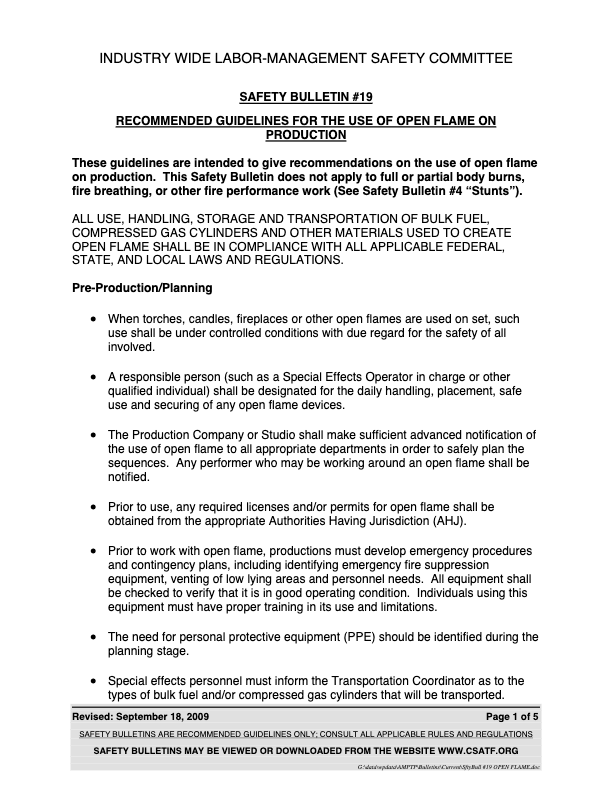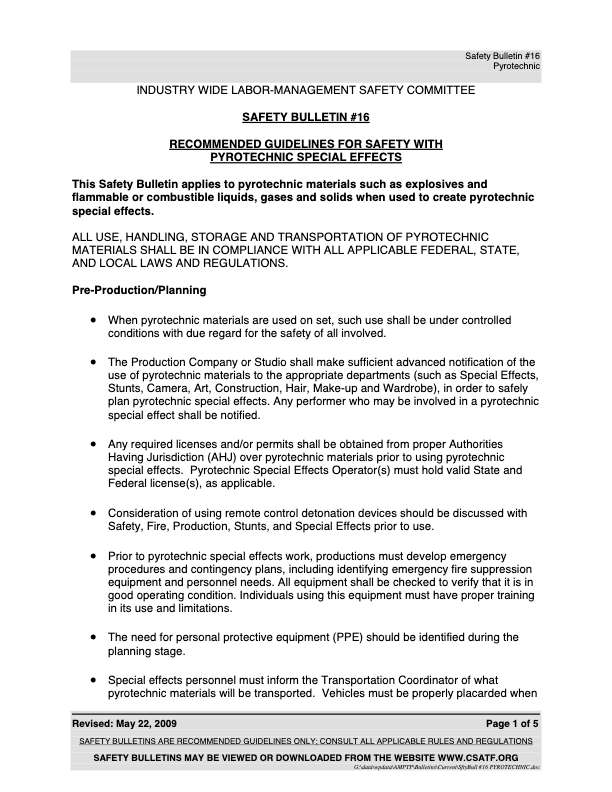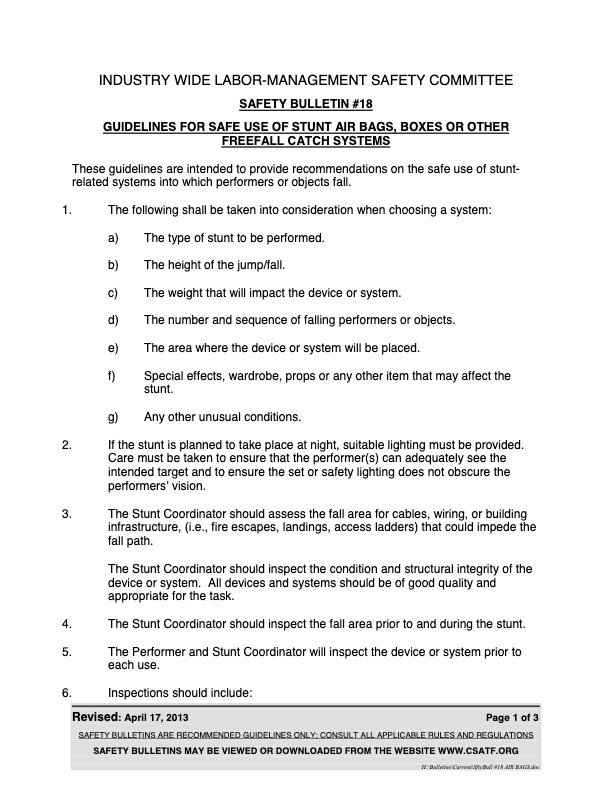Safety Bulletin

Guidelines
These guidelines are intended to give recommendations on the use of open flame on production. This Safety Bulletin does not apply to full or partial body burns, fire breathing, or other fire performance work (See Safety Bulletin on “Stunts”).
All use, handling, storage and transportation of bulk fuel, compressed gas cylinders and other materials used to create open flame shall be in compliance with all applicable federal, state, and local laws and regulations.
Pre-Production/Planning
- When torches, candles, fireplaces or other open flames are used on set, such use shall be under controlled conditions with due regard for the safety of all involved.
- A responsible person (such as a Special Effects Operator in charge or other qualified individual) shall be designated for the daily handling, placement, safe use and securing of any open flame devices.
- The Production Company or Studio shall make sufficient advanced notification of the use of open flame to all appropriate departments in order to safely plan the sequences. Any performer who may be working around an open flame shall be notified.
- Prior to use, any required licenses and/or permits for open flame shall be obtained from the appropriate Authorities Having Jurisdiction (AHJ).
- Prior to work with open flame, productions must develop emergency procedures and contingency plans, including identifying emergency fire suppression equipment, venting of low lying areas and personnel needs. All equipment shall be checked to verify that it is in good operating condition. Individuals using this equipment must have proper training in its use and limitations.
- The need for personal protective equipment (PPE) should be identified during the planning stage.
- Special effects personnel must inform the Transportation Coordinator as to the types of bulk fuel and/or compressed gas cylinders that will be transported. Vehicles must be properly placarded when required by Federal or State law. All vehicles transporting bulk fuel or compressed gas cylinders shall have an inventory of the materials being transported or stored readily available. Drivers must be qualified to transport these materials.
- Sets, equipment, props, wardrobe, make-up, wigs, hair supplies, etc., that will be in close proximity to open flame must be prepared accordingly and/or should be made of flame retardant material. All sets, equipment, props, wardrobe, wigs, etc., must be made available in advance to the designated responsible person for evaluation, to establish placement, and if necessary, for testing.
Clothing and Personal Protective Equipment
- Cast and crew in close proximity to open flame should wear appropriate protective clothing. Depending on the hazards involved, this clothing should include appropriate closed-toe footwear, long pants, and a long-sleeved shirt made of 100% cotton or material which provides equal or greater protection.
- Cast and crew must be notified by the designated responsible person when there is potential for exposures to open flame. PPE must be provided as appropriate for the hazard(s) involved and considerations must be made for head, hand, eye, ear and respiratory protection. Depending on the hazards involved, the AHJ may require full fire turnout gear and Self-Contained Breathing Apparatus (SCBA). These guidelines will also apply to performers when appropriate. All users must have proper training in the use and limitations of such PPE.
Fire Protection
- All stationary open flame devices should be firmly secured.
- Flammables and combustibles, including bulk fuel, compressed gas cylinders and highly concentrated dust effects, shall be kept a safe distance from open flame and other sources of ignition. Where required, such materials shall also be stored in approved, properly labeled containers.
- All lines and fittings used in the delivery of fuel gas to open flame devices shall be appropriate for the fuels being used, (i.e., natural gas usage requires different hoses and fittings than liquid petroleum gas).
- “No Smoking” signs shall be posted in all areas where fuel and compressed gas cylinders are stored and handled.
- Sufficient fire suppression equipment (such as charged extinguishers and fire hoses) must be manned, ready for use and placed at an appropriate safe distance from the open flame during testing, rehearsal and filming.
- Designated personnel performing fire suppression activities during testing, rehearsal and filming must be properly clothed and wear appropriate PPE.
Personnel Using and Handling Open Flame
- Personnel working with open flame should be dressed in appropriate clothing to protect them from potential hazards. Depending on the hazards involved, clothing should consist of appropriate closed-toe footwear, long pants, and a long-sleeved shirt made of 100% cotton or material which provides equal or greater protection. PPE considerations must be made for head, hand, eye, ear and respiratory protection. Depending on the hazards involved, the AHJ may require full fire turnout gear.
- Intoxicating liquids, drugs and other controlled substances (except for prescription drugs not impairing the user’s judgment and motor functions) shall not be used by any person involved in open flame effects at any time during transportation, set-up, use or removal.
- Personnel working with or around open flame must be given sufficient time to safely perform the work (including the transporting, storing, creating, rigging, igniting, striking and extinguishing of all open flame devices and materials). While conducting such duties, personnel should not be rushed, interrupted or distracted from focusing on their work.
- The rigging of any type of open flame device to a performer shall be done by a qualified special effects operator, with the consultation of the stunt coordinator if applicable.
- When igniting and maintaining an open flame, it must be continuously observed and controlled by the designated responsible person, unless equal means of observation are used.
Awareness
- When using open flame on any set, notification shall be given to personnel by way of the call sheet, or other suitable means. The call sheet should also state the type of open flame work that is planned.
- Before any open flame effects or potentially hazardous sequence is to be performed, all persons involved shall be thoroughly briefed at a safety orientation meeting on the site.
- The safety orientation meeting shall include an “on-site walk-through” and/or “dry run” with the designated responsible person and all other persons involved in the event, including Stunt Coordinator if applicable. PPE should be in place at that time.
- If practical and upon a reasonable and timely request, the designated responsible person may conduct a test of the open flame when it is in the vicinity of cast and crew.
- If at any time a significant change in open flame use becomes necessary, the First Assistant Director will again call all persons involved in the event to another meeting to confirm everyone understands the proposed change(s).
Emergency Procedures
- Emergency procedures and contingency plans, including appropriate signs and signals and authority to abort the shot, shall be specified prior to engaging in any open flame work.
- Before the use of open flame on set, the First Assistant Director, or designee, shall clearly announce to all persons the location of exits, the primary escape route and alternate escape routes. Escape routes must provide a clear and unobstructed passage to a designated safe area.
- Each person should ensure their designated escape routes are clear and remain accessible. Any person who is unsure of their designated escape routes should check with the First Assistant Director and learn of the escape routes upon entering the work area.
- In the event of an emergency, only those designated with emergency response roles should enter the open flame area.
Authorized Personnel in the Open Flame Area
- Access to areas where open flame is rigged or present should be limited to authorized personnel only. All other personnel shall remain at a designated safe distance. If needed to prevent unintentional entry into hazardous areas, warning signs should be posted and/or other appropriate precautions taken.
- Prior to using open flame with minors present, key production personnel, such as the Director, First Assistant Director, designated responsible person, Stunt Coordinator and safety professional, should confer with the minor, minor’s parent/legal guardian and Studio Teacher to review and discuss the planned activity. The production shall consider any reasonable request from the minor, minor’s parent/legal guardian, and/or Studio Teacher regarding the minor’s proximity to any open flame.
Safety on the Set After Use of Open Flame
- After each use of open flame, no one shall enter the area other than the designated responsible person(s), until it is declared safe. This includes testing, rehearsals and filming.
- Appropriate fire watch, as determined by the AHJ, should be maintained after each open flame event.




